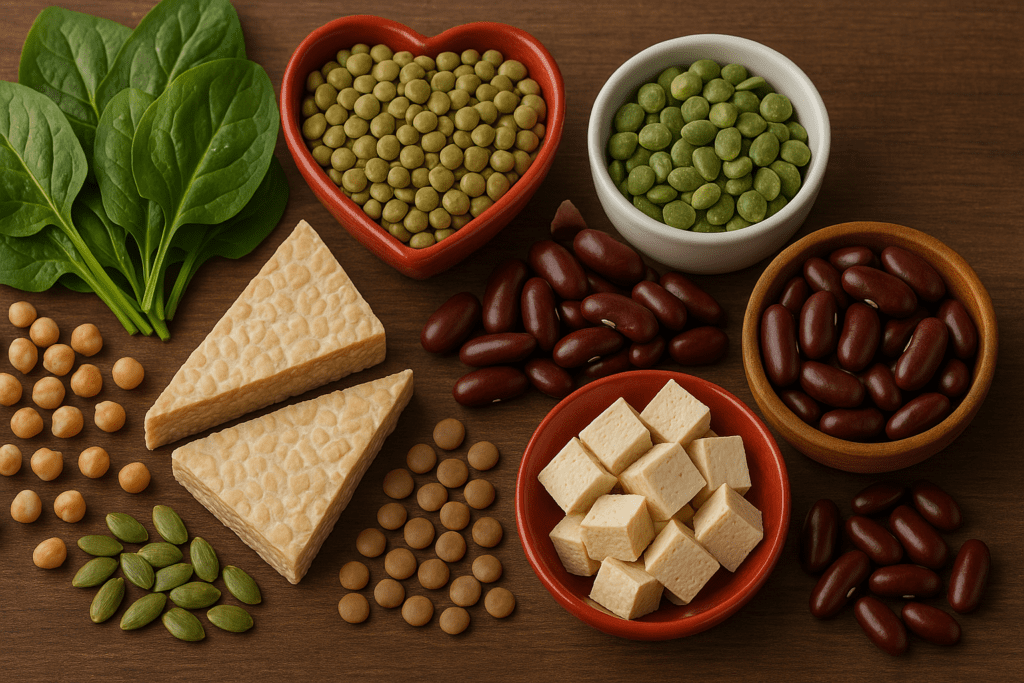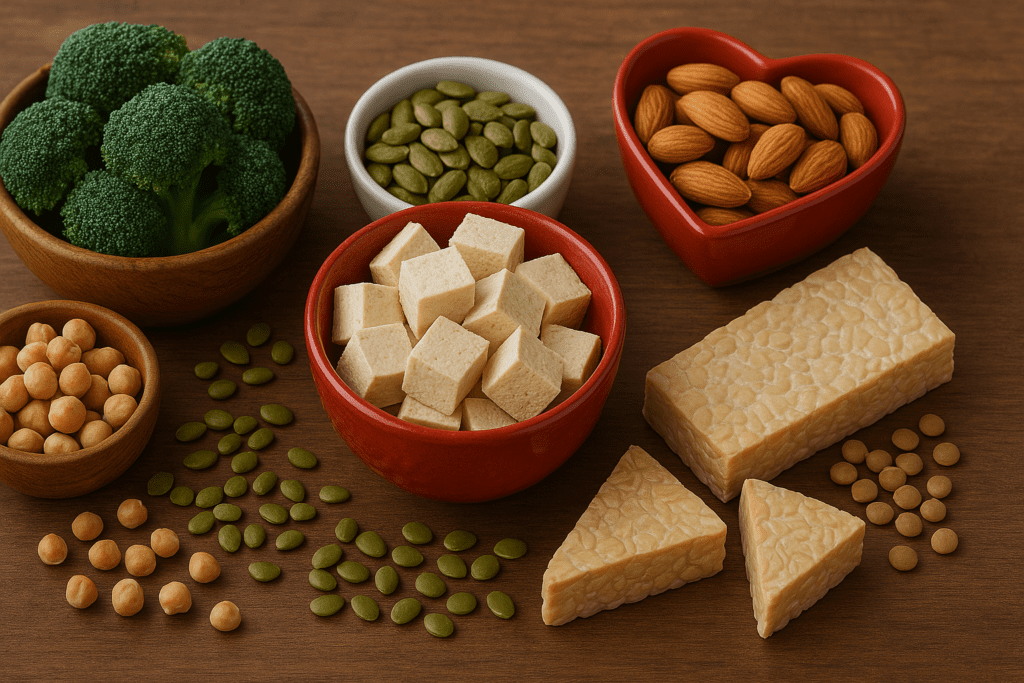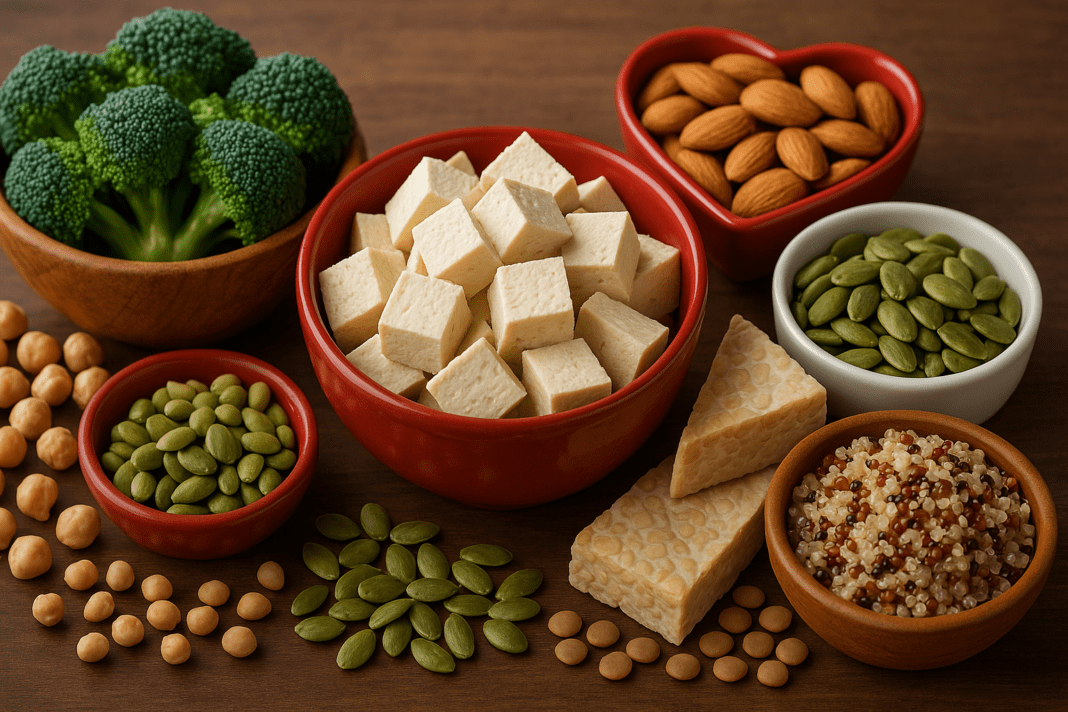Protein is a vital macronutrient, but not all protein sources contribute equally to heart health. While traditional diets often emphasize animal products, emerging research highlights that many plant-based foods provide not only sufficient protein but also cardiovascular benefits. These heart healthy protein foods are naturally low in saturated fat, free of cholesterol, and rich in nutrients that promote long-term wellness. For those interested in a plant-based lifestyle, understanding how to incorporate these foods effectively can significantly enhance heart health outcomes.
You may also like: How a Plant-Based Diet May Help Reduce Cancer Risk: What Science Says About Nutrition and Tumor Prevention
This article explores the best heart healthy protein sources within a plant-based diet. It will unpack their nutritional benefits, explain how they support cardiovascular health, and offer practical ways to incorporate them into everyday meals. Whether you’re fully plant-based or simply looking to reduce animal products, this guide provides the evidence-based insights needed to optimize your protein intake for heart wellness.
Legumes: Nutrient-Rich Powerhouses for the Heart
Legumes—including beans, lentils, peas, and chickpeas—stand out as excellent heart healthy protein foods. They’re naturally high in protein and fiber, which work synergistically to reduce LDL cholesterol, improve digestion, and stabilize blood sugar. The soluble fiber in legumes binds with bile acids in the digestive tract, helping to eliminate excess cholesterol from the body. As a result, regular legume consumption is linked to reduced rates of cardiovascular disease.
These versatile staples are also rich in iron, magnesium, potassium, and polyphenols—each of which plays a role in cardiovascular support. Their low glycemic index makes them a particularly good choice for those managing type 2 diabetes or metabolic syndrome, conditions closely tied to heart health. From black beans in burritos to red lentils in curries, legumes can be seamlessly integrated into meals across cuisines.

Nuts and Seeds: Calorie Dense, Nutrient Dense, and Heart Smart
Nuts and seeds are among the most concentrated plant-based sources of heart healthy protein. Almonds, walnuts, chia seeds, flaxseeds, hemp seeds, and sunflower seeds offer a rich mix of protein, unsaturated fats, fiber, and antioxidants. Their cardioprotective benefits are well documented in clinical studies, with regular consumption linked to lower cholesterol, reduced inflammation, and improved endothelial function.
Walnuts, in particular, are high in alpha-linolenic acid (ALA), a plant-derived omega-3 fatty acid that supports heart rhythm and reduces arterial stiffness. Chia and flaxseeds are excellent sources of soluble fiber and lignans, compounds known for their antioxidant and anti-inflammatory effects. Just a handful of nuts or a tablespoon of seeds added to smoothies, salads, or whole grain bowls can deliver a meaningful nutritional boost.

Whole Grains: Steady Energy and Sustained Heart Health
Whole grains such as quinoa, brown rice, oats, buckwheat, and farro contribute not only to protein intake but also to cardiovascular protection. Unlike refined grains, whole grains retain their fiber-rich outer layers and germ, which supply essential nutrients and antioxidants. The fiber in whole grains helps regulate blood lipids, control blood sugar, and support a healthy gut microbiome—all of which influence cardiovascular outcomes.
Quinoa, often labeled a “complete protein,” contains all nine essential amino acids. Its versatility and nutrient density make it a staple in plant-based kitchens. Oats, another standout grain, are high in beta-glucan—a type of soluble fiber known to lower LDL cholesterol. Including these grains regularly helps round out a plant-based diet with sustained energy and heart-supportive nutrition.

Vegetables That Deliver More Than Expected
While not commonly associated with protein, certain vegetables contribute modest yet meaningful amounts to your daily intake, especially when consumed in larger servings. Cruciferous vegetables like broccoli, kale, and Brussels sprouts are high in fiber, antioxidants, and anti-inflammatory compounds. Spinach and green peas are particularly protein-rich among vegetables and also provide vital nutrients such as iron, vitamin K, and folate.
Even starchy vegetables like sweet potatoes and corn offer trace amounts of protein along with potassium, which plays a key role in blood pressure regulation. Incorporating a variety of colorful vegetables ensures a broad spectrum of nutrients while subtly increasing protein intake throughout the day. These foods also enhance meal volume and satiety, aiding weight control—another key factor in heart disease prevention.
Soy Foods: A Complete Protein with Heart Health Benefits
Soy-based products such as tofu, tempeh, edamame, and soy milk are complete proteins and have long been associated with cardiovascular benefits. Rich in isoflavones, soy foods help improve arterial function, reduce blood pressure, and lower LDL cholesterol. Tofu and tempeh are highly adaptable in cooking, while soy milk serves as a fortified alternative to dairy for those seeking calcium and vitamin D.
Fermented soy products like tempeh also support gut health through probiotic content, indirectly benefiting cardiovascular function by reducing systemic inflammation. Edamame makes for a convenient, high-protein snack that fits well into any diet. Regular inclusion of soy products in plant-based eating patterns is supported by research demonstrating reduced risk of coronary heart disease when replacing red meat or processed meats.
Complementary Proteins and Dietary Balance
Balancing protein on a plant-based diet is less about combining foods in one meal and more about consuming a variety throughout the day. Whole grains and legumes complement each other well, as do nuts, seeds, and vegetables. This approach, known as protein complementation, ensures that all essential amino acids are available to the body for tissue repair, immune function, and metabolic regulation.
Understanding how different foods contribute to the amino acid profile is important for those new to plant-based eating. While it’s rare for anyone consuming sufficient calories from whole plant foods to be deficient in protein, awareness of variety helps optimize intake. Eating lentil stew with whole grain bread, or hummus with pita, is more than tasty—it’s nutritionally strategic.
Beyond Protein: Fiber, Phytochemicals, and Anti-Inflammatory Support
Plant-based protein foods come with added benefits that go far beyond amino acids. Soluble and insoluble fibers help regulate cholesterol, improve bowel regularity, and foster a healthy gut microbiome. Phytochemicals—such as flavonoids, polyphenols, and carotenoids—offer antioxidant and anti-inflammatory effects that directly influence cardiovascular health.
This nutritional synergy is unique to whole plant foods. Unlike isolated protein powders or ultra-processed meat substitutes, these heart healthy protein sources deliver a complete matrix of nutrients that work together to reduce oxidative stress, stabilize blood sugar, and protect vascular integrity. Choosing unprocessed or minimally processed options ensures these benefits remain intact.
Frequently Asked Questions: Heart Healthy Protein Foods on a Plant-Based Diet
1. Can heart healthy protein from plants support muscle growth and athletic performance?
Absolutely. While animal protein has long been favored in athletic circles, recent studies have shown that plant-based diets can effectively support muscle synthesis and performance, provided they meet caloric and protein requirements. Many heart healthy protein sources like soy, lentils, and quinoa offer complete or near-complete amino acid profiles, especially when paired strategically. Plant-based athletes often incorporate higher volumes of food to compensate for lower calorie density, allowing for sufficient intake of heart healthy protein foods without excess saturated fat. Additionally, plant-based diets may reduce inflammation and promote faster recovery, making them a viable option for endurance and strength athletes alike.
2. Are there specific cooking techniques that help maximize the absorption of heart healthy protein?
Yes, preparation methods can significantly impact how well your body utilizes the protein from plant foods. Soaking, sprouting, and fermenting beans, grains, and seeds not only enhance nutrient bioavailability but also reduce anti-nutrients like phytic acid, which can inhibit mineral absorption. For example, fermented soy products such as tempeh are among the most digestible heart healthy protein foods and are particularly gut-friendly. Cooking legumes thoroughly breaks down fibers and improves protein digestibility, while combining them with vitamin C-rich foods (like bell peppers or citrus) aids in iron absorption. These methods ensure that your body reaps the full nutritional benefits of heart healthy protein sources.
3. How can busy professionals consistently incorporate heart healthy protein into a hectic schedule?
Meal planning and smart batching are essential strategies. Preparing large portions of heart healthy protein foods such as chickpea salad, lentil soup, or quinoa bowls in advance allows for easy assembly of nutrient-dense meals throughout the week. Portable snacks like roasted edamame, mixed nuts, and homemade trail mix with seeds offer convenient, on-the-go heart healthy protein sources. Investing in a quality blender also helps create quick smoothies with protein-packed ingredients like hemp seeds, oats, and nut butter. By creating a modular meal prep system, busy individuals can avoid defaulting to less nutritious options without sacrificing flavor or convenience.
4. Are there cultural or traditional diets that successfully rely on heart healthy protein foods?
Indeed, many global cuisines have long embraced plant-based eating, showcasing a rich history of nutrient-dense, heart healthy protein sources. For instance, Indian, Ethiopian, Mediterranean, and Southeast Asian diets frequently use lentils, chickpeas, tofu, and whole grains as staples. These cultures not only rely on heart healthy protein foods for sustenance but also pair them with antioxidant-rich herbs, spices, and vegetables, enhancing cardiovascular benefits. Studying these traditions can inspire modern adaptations and add variety to one’s dietary approach. Learning from these established culinary frameworks makes the transition to plant-based protein both flavorful and culturally enriching.
5. What are some emerging or underutilized heart healthy protein sources to watch for?
Several lesser-known plants are gaining traction as heart healthy protein powerhouses. Lupini beans, for example, offer a high-protein, low-carb profile with minimal fat. Water lentils (also known as duckweed) are being explored as a sustainable, protein-rich crop with a complete amino acid profile. Sacha inchi seeds, rich in protein and omega-3 fatty acids, are making their way into snack aisles and health food stores. These novel heart healthy protein foods not only diversify the plant-based pantry but also align with ecological sustainability and food security trends. Staying informed about these innovations opens up new possibilities for nourishing the body while protecting the planet.
6. How can older adults meet their protein needs using heart healthy protein sources?
As we age, maintaining muscle mass and bone density becomes increasingly important, and protein plays a key role. However, older adults often experience decreased appetite, making nutrient density even more critical. Heart healthy protein foods such as tempeh, lentils, chia seeds, and fortified plant milks provide concentrated nutrition in relatively small portions. Incorporating these into soft-textured dishes like soups, porridges, and smoothies can make them easier to consume. Regular strength training and resistance exercises further enhance the body’s ability to use the protein for muscle maintenance and recovery, underscoring the synergistic role of diet and physical activity.
7. Can heart healthy protein foods help manage cholesterol levels?
Yes, and quite effectively. Unlike animal proteins, which often contain saturated fats and dietary cholesterol, heart healthy protein sources come bundled with fiber, particularly soluble fiber, which actively helps reduce LDL cholesterol. Foods such as oats, beans, and flaxseeds have been studied for their lipid-lowering effects and are often recommended in clinical dietary interventions. The phytochemicals and plant sterols found in many heart healthy protein foods also contribute to improved cholesterol ratios. A consistent intake of these foods, especially when replacing red or processed meat, can be a powerful strategy for improving lipid profiles.
8. What role do heart healthy protein sources play in blood sugar control?
Heart healthy protein helps stabilize blood glucose by slowing digestion and blunting post-meal spikes. Legumes, nuts, and whole grains have a low glycemic index and are absorbed more slowly, providing a more sustained energy release. For individuals with insulin resistance or type 2 diabetes, choosing heart healthy protein foods can help maintain glycemic balance and reduce reliance on quick-fix carbohydrates. Pairing protein with fiber-rich vegetables further slows absorption and promotes satiety. This approach not only supports cardiovascular health but also enhances metabolic flexibility and reduces the risk of long-term complications.
9. Is it possible to over consume plant-based heart healthy protein?
While it’s rare, overconsumption is theoretically possible—particularly with processed protein supplements and fortified products. Whole-food heart healthy protein sources naturally come with fiber and water content, which promote fullness and regulate appetite, making excessive intake unlikely. However, relying too heavily on concentrated powders or bars may lead to an imbalanced diet lacking in micronutrients. It’s also important to consider the sodium and additive content in some commercial products. As with any diet, variety and moderation are key to ensuring that heart healthy protein foods contribute positively to overall wellness.
10. What psychological or behavioral benefits come with increasing heart healthy protein foods?
Incorporating more heart healthy protein into one’s diet often leads to improved energy levels, better focus, and enhanced mood stability. Protein-rich meals support neurotransmitter production, including serotonin and dopamine, which play crucial roles in emotional regulation. The satiety provided by heart healthy protein sources can reduce irritability caused by blood sugar crashes and curb emotional eating. Additionally, the act of consciously choosing nutrient-dense foods often leads to a more mindful and intentional approach to eating, fostering a healthier relationship with food overall. Over time, this shift can have profound effects not only on physical health but also on self-efficacy and emotional well-being.
Conclusion: Building a Heart-Healthy Diet with Plant-Based Protein
Choosing the right heart healthy protein foods within a plant-based framework offers a powerful and practical way to support cardiovascular wellness. From beans and lentils to whole grains, nuts, seeds, soy, and even vegetables, these foods provide high-quality protein while also supplying fiber, antioxidants, vitamins, and minerals that nourish the heart. Unlike animal-based proteins that may raise cholesterol and inflammation, plant proteins contribute to long-term heart protection.
Transitioning to or maintaining a plant-based diet does not require sacrifice—it invites variety, flavor, and a deeper connection to health. By understanding how to incorporate a range of heart healthy protein sources into your daily meals, you can fuel your body with everything it needs to thrive. More importantly, you lay the foundation for a lifestyle that promotes not just longevity, but vitality at every stage of life. Through thoughtful, evidence-based choices, the path to a healthier heart begins on your plate.
plant-based protein options, cardiovascular nutrition, foods for heart health, vegan protein sources, cholesterol-lowering foods, plant-based meal planning, high-fiber diets, anti-inflammatory foods, legumes for heart health, whole grains and heart wellness, soy nutrition benefits, plant-powered diets, vegan heart health tips, natural sources of protein, dietary strategies for heart disease, balanced plant-based eating, vegan sources of amino acids, heart-supportive nutrients, healthy plant-based meals, protein-rich vegan foods
Further Reading:
For a Healthy Heart, Follow a Plant-Based Diet
A Heart-Healthy Diet for Cardiovascular Disease Prevention: Where Are We Now?
Disclaimer
The information contained in this article is provided for general informational purposes only and is not intended to serve as medical, legal, or professional advice. While NewsHealthWatch strives to present accurate, up-to-date, and reliable content, no warranty or guarantee, expressed or implied, is made regarding the completeness, accuracy, or adequacy of the information provided. Readers are strongly advised to seek the guidance of a qualified healthcare provider or other relevant professionals before acting on any information contained in this article. NewsHealthWatch, its authors, editors, and contributors expressly disclaim any liability for any damages, losses, or consequences arising directly or indirectly from the use, interpretation, or reliance on any information presented herein. The views and opinions expressed in this article are those of the author(s) and do not necessarily reflect the official policies or positions of NewsHealthWatch.

